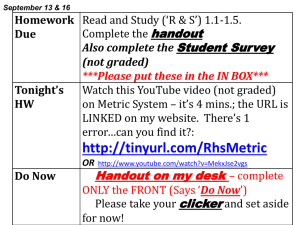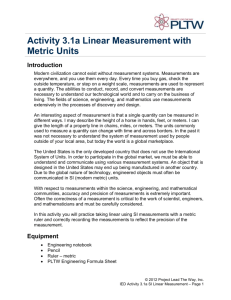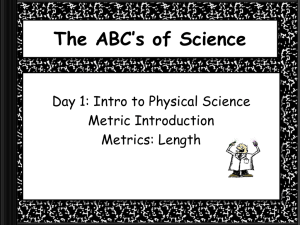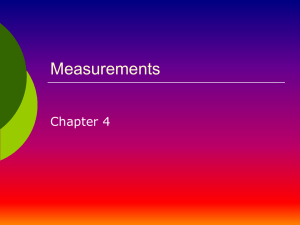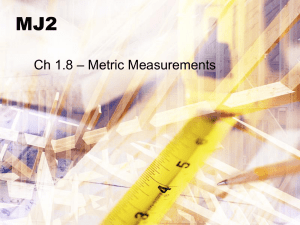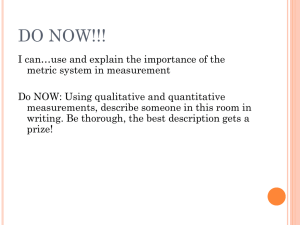Meters, Liters & Grams *Oh My!
advertisement
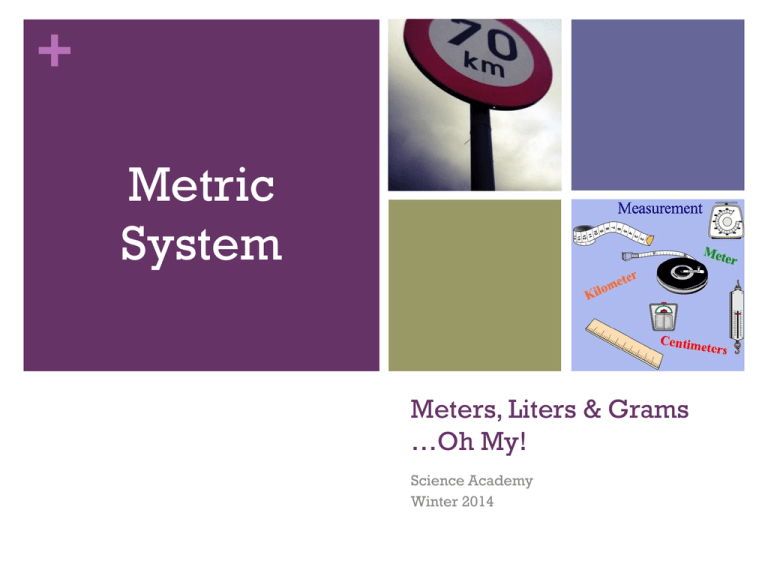
+ Metric System Meters, Liters & Grams …Oh My! Science Academy Winter 2014 + Pat Naughtin: Saving Millions with the Metric System http://youtu.be/_lshRAPvPZY + Metric System The metric system is the standard system of measurement in much of the world and is also used in the sciences in the United States. Mass is measured in grams. Length is measured in meters. Volume is measured in liters. Temperature is measured in °Celsius + Metric System Larger and smaller units of mass, length, and volume are calculated in units of 10 and use the same prefixes. Kilometer (km) 1000 meters Meter (m) Centimeter (cm) 0.01 meter 100 cm make 1 m Millimeter (mm) 0.001 meter 1000 mm make 1 m, 10 mm make 1 cm Micrometer (µm) 0.000001 meter 1000 µm make 1 mm + Metric System Goals for today: Become familiar with meters, liters, grams, and °C. Practice making conversions. + Metric System Measure the diameter of this circle in centimeters. Convert to meters. Convert to millimeters. + Metric System How many kiloliters are there in a 2-liter bottle of soda? + Metric System If a car is traveling at 100 km per hour, how fast is that in meters per second? Name Metric Conversions Fill in the boxes in the stair step diagram. Try these conversions, using the ladder method. 1000 mg = g 14 km = m 1L= 109 g = mL 160 cm = kg 250 m = Compare using <, >, or =. 56 cm 6m 7g T. Trimpe 2000 http://sciencespot.net/ 698 mg mm km + Metric Mini-Olympics! Estimate and Measure! Paper Straw Javelin Throw Paper Plate Discus Cotton Ball Shot Put Right-Handed Left-Handed Big Marble Grab Sponge Squeeze Foot was Here! + Metric Scavenger Hunt Search & Solve! Teams will search for cards and solve the problems on the cards. Check Go your answer with an instructor. find another card. The team that solves the most problems wins! + Listening Getting the Most out of Lectures + Why is it so hard to pay attention? Pseudo-listening – taking mental vacations. Selective listening – getting distracted by a wandering mind. Critical listening – thinking negative thoughts about the speaker that interfere with your ability to follow along. + How can I stay focused? Awareness Once you notice the problem – stop! Be is key! physically and mentally prepared to listen. Get enough sleep. Don’t go to class hungry. Bring water with you. Be aware when your mind drifts toward your troubles – try to leave them outside the classroom. + How can I stay focused? Set a goal for yourself to stay focused 100% of the time. It is your job to pay attention. Sit front and center! See better Hear better Fewer distractions Easier to participate Harder to fall asleep + Practice Listening! Listen Wait to each sentence while I read it. until I finish before you write anything down. Write the sentence exactly as I said it. + Practice Listening! How did you do? In a real lecture, you don’t have to wait until the speaker finishes before writing. Also, you don’t take notes word-for-word. But, accuracy is important! Did any of your errors change the meaning of the sentence? Your listening skills can improve dramatically with practice. + Pretend to be fascinated! Fake it ‘til you make it! Lean forward in your chair. Follow the speaker visually. Slouching posture actually sends a message to the brain that what you are hearing isn’t important. Sitting up straight with attentive posture tells your brain to pay attention! + Notetaking Getting the Most out of Lectures + Why take notes? Notes give you a good study tool. Instructors often tell you what questions to expect on the exam – write them down!!! Taking notes keeps you focused. + Come to Class Prepared 10-30 minutes Before lecture, review your notes from the previous lecture. Preview the chapter you will be discussing in lecture. At least look through the headings of the chapter, check out the figures, read the summary. + Taking Good Notes When Go on a diet! Your notes that is. Don’t write every word. Use abbreviations – decide on abbreviations ahead of time. Keep a list of abbreviations. Know in doubt, write it down! your instructor. Have instructor look at your notes. + Taking Good Notes Type or rewrite your notes after class. Can be useful if your notes are barely legible, have many gaps, or are very disorganized. Use a good note-taking system. + Cornell Note-Taking System Draw lines to make a wide left margin and a bottom margin. Name: Key Points Date: Period: Details In class, only use the large area for your notes. Later, add key words to the left and a summary at the bottom. Study your notes by covering the main notes, then read the key words or headings and go over the things you need to know about that subject. Summary Freeology.com – Free School Stuff + Cornell Note-Taking System + Note-Taking Methods Outlining method – organize material as you go. Charting method- uses categories like an excel spreadsheet. Mapping Sentence method – great for visual learners. method – works better than paragraphs when you aren’t sure how all the ideas fit together.


